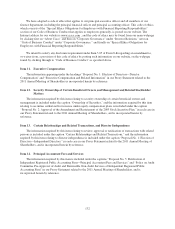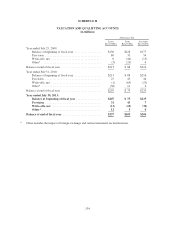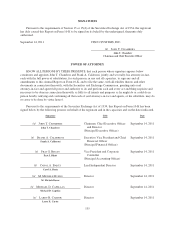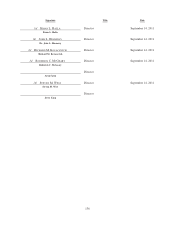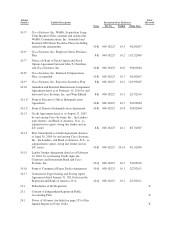Cisco 2011 Annual Report Download - page 150
Download and view the complete annual report
Please find page 150 of the 2011 Cisco annual report below. You can navigate through the pages in the report by either clicking on the pages listed below, or by using the keyword search tool below to find specific information within the annual report.Forward-Looking Statements
This Annual Report contains forward-looking statements regarding future events and our future results that are
subject to the safe harbors created under the Securities Act of 1933 and the Securities Exchange Act of 1934,
each as amended. These statements are based on current expectations, estimates, forecasts, and projections about
the industries in which we operate and the beliefs and assumptions of our management. Words such as “expects,”
“anticipates,” “targets,” “goals,” “projects,” “intends,” “plans,” “believes,” “seeks,” “estimates,” “continues,”
“endeavors,” “strives,” “may,” variations of such words, and similar expressions are intended to identify such
forward-looking statements. In addition, statements that refer to the following are forward-looking statements:
increasing our ability to continue to deliver unique value to shareholders, customers, partners and employees,
including meeting the goal of driving earnings growth faster than revenue growth; our architectural approach, our
scale advantages and the breadth and depth of our portfolio continuing to be key reasons for our success; our
ability to accelerate decision-making speed and the pace of innovation, to increase accountability and alignment,
and to drive productivity improvements, and through these to increase our ability to capitalize on our five
foundational priorities and to support opportunities in emerging countries; the network continuing to grow in
importance and possibly becoming the most strategic information technology (IT) asset; our ability, through the
delivery of integrated and differentiated intelligent networks and technology architectures, to help customers
solve important business and technology issues, increase competitive advantage and increase profitability, and to
achieve our business goals relating to the next technology-related transition in the market; our network-centric
platform changing the nature of work and the way we live; and other characterizations of future events or
circumstances. Readers are cautioned that these forward-looking statements are only predictions and may differ
materially from actual future events or results due to a variety of factors, including: business and economic
conditions and growth trends in the networking industry, our customer markets and various geographic regions;
global economic conditions and uncertainties in the geopolitical environment; overall information technology
spending; the growth and evolution of the Internet and levels of capital spending on Internet-based systems;
variations in customer demand for products and services, including sales to the service provider market and other
customer markets; the return on our investments in certain market adjacencies and geographical locations; the
timing of orders and manufacturing and customer lead times; changes in customer order patterns or customer
mix; insufficient, excess or obsolete inventory; variability of component costs; variations in sales channels,
product costs or mix of products sold; our ability to successfully acquire businesses and technologies and to
successfully integrate and operate these acquired businesses and technologies; increased competition in our
product and service markets, including the data center; dependence on the introduction and market acceptance of
new product offerings and standards; rapid technological and market change; manufacturing and sourcing risks;
product defects and returns; litigation involving patents, intellectual property, antitrust, shareholder and other
matters, and governmental investigations; natural catastrophic events; a pandemic or epidemic; our ability to
achieve the benefits anticipated from our investments in sales and engineering activities; our ability to recruit and
retain key personnel; our ability to manage financial risk, and to manage expenses during economic downturns;
risks related to the global nature of our operations, including our operations in emerging markets; currency
fluctuations and other international factors; changes in provision for income taxes, including changes in tax laws
and regulations or adverse outcomes resulting from examinations of our income tax returns; potential volatility in
operating results; and other factors listed in Cisco’s most recent report on Form 10-K contained in this Annual
Report. Our results of operations for the year ended July 30, 2011 are not necessarily indicative of our operating
results for any future periods. We undertake no obligation to revise or update any forward-looking statements for
any reason.


